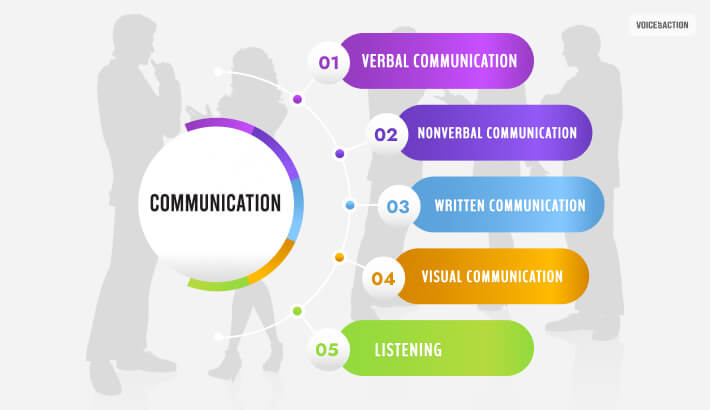What Are The Different Forms Of Communication: Explained

Growing up, we have never given much thought to something as vital as communication. Your communication skills only come under the limelight when you are sitting in front of the interviewer, trying to nail your dream job. And sometimes things just don’t work out – you might not be familiar with different forms of communication.
Or your communication skills might need some improvement. There could be so many different reasons – but the point is to work on all your flaws and appear absolutely ready in your interview. If communication is one of your concerns, then why wait? Scroll down and read about the different communication forms – it might just help you more than you expected!
What Are The Different Forms Of Communication: Explained

While old forms of communication refer to face-to-face conversations, facial expressions, or even body language, the world at large recognizes five different forms of communication.
These communication forms are as follows,
- Verbal Communication,
- Nonverbal Communication,
- Written Communication,
- Visual Communication, and
- Listening.
The names mentioned above are the five basic types of communication – you just need to focus on these five types, and you will be sorted. So without wasting any time, let’s check out each of these communication forms.
1. Verbal Communication:

Verbal forms of communication take place when you engage or rather speak with others. Naturally, it can be conducted over your phone, face-to-face, or even digitally via video calls.
While certain verbal engagements, such as chatting with your colleagues at a common workspace or with your friends over dinner, are considered to be informal. Similarly, other types of verbal communication, like a meeting with your boss, is, of course, formal.
However, it’s not just about the type or the words but also about the complexity, caliber, and intonation which affects your verbal communication skills. Also, when verbal communication takes place face-to-face, it cannot really be different from nonverbal communication.
To Know More:-

2. Nonverbal Communication:

Unlike the forms of verbal communication, nonverbal communication is more than your actual words. So facial expressions, hand movements, touch, posture, and eye contact – all together play a huge role in nonverbal communication modes.
For instance, when you are engaged in some conversation at work, you will naturally pay attention to both the spoken words and the unspoken body language. It is very easy to understand with the help of nonverbal communication whether or not your colleagues are in agreement or disagreement with your pitch.
It is also possible that your colleagues might agree with your verbally, but watch out for their nonverbal communication cues – are they avoiding eye-contact with you? Is there some sighing? A scrunched-up face, maybe? Yes, all of these signs point out a different meaning.
3. Written Communication:

It can be a report, a Tweet, a memo, a Facebook post, a contract, or even an email – but all these are written communication. When you are communicating information by writing it down, it’s known as written communication. The goal? To convey information in a manner that’s concise and clear.
However, if your writing skills are poor, then it can lead to embarrassment, confusion, and even legal jeopardy. Amongst all the forms of communication, this one perhaps requires the most effort. In the digital age, you must remember that what you are choosing to write down will live on, sometimes, even in perpetuity.
In that case, it is vital that you understand that when you make careless errors or write down poorly constructed lines, it makes you appear bad. Secondly, you also have to ensure that your message content is something that you actually want to be associated with or even promote in the long run.
4. Visual Communication:

There’s no need to look for alternative forms of communication – think about it! We are living in a digital age that is very much visual. From social media content to televisions, everything is visual today. In fact, social media platforms like Instagram happen to be image-only, which means it’s a completely visual platform.
Visual communication is technically a kind of mass communication. In the majority of time, when someone communicates visually, they are communicating with a larger audience. A film, or even a television ad, is intended for a larger audience and not just a few people. Of course, video calls are also a type of visual communication.
Visual communication, thereby, includes all the selfies you send on your WhatsApp groups, the snaps your send for maintaining streaks, or even the reels you make for your followers on socials. The world is only becoming aware of the potential that visual communication possess – just wait for a few more years and watch!
5. Listening:

The world might keep coming up with different forms of technical communication, but if there is one communication form that has managed to live on, then that has to be listening. Communication happens only when there is a receiver, too – an exchange between a sender and a receiver.
Out of all the forms of communication, no matter which one you will choose for sending information. The point is the process will stay incomplete unless there’s a receiver to receive your information. How will you engage or, even better, communicate with someone if you are not an active listener?
The whole process of communication depends on sending and receiving – so active listening is perhaps one of the most crucial aspects of communication. The whole process stays incomplete without listeners to receive the information and complete the process.
Frequently Asked Questions (FAQs):
Check out the most frequently asked questions about forms of communication mentioned in detail below.
Ans: There are three main forms of communication. These are as follows,
• Visual Communication,
• Verbal Communication, and
• Nonverbal Communication.
Ans: The five types of communication are as follows,
• Written communication,
• Listening,
• Visual Communication,
• Nonverbal Communication, and
• Verbal Communication.
Ans: The 7 forms of communication are as follows,
• Non-Verbal Communication,
• Verbal Communication,
• Visual Communication,
• Feedback Communication,
• Group Communication,
• Written communication, and
• Mass Communication.
Ans: There are four main types of communication that are widely used by everyone. These communication forms are as follows,
• Verbal,
• Written,
• Nonverbal, and
• Visual.
And It’s A Wrap!
Of course, there are other forms of communication apart from the five different types we have already mentioned above. For instance, there’s spatial communication which deals with using space in texts for conveying certain specific messages and meanings. There are other similar minor communication types, but the ones we have mentioned are the basic types.
So, don’t forget to let us know your thoughts and experiences related to different communication types in the comments below.
Read More:


























